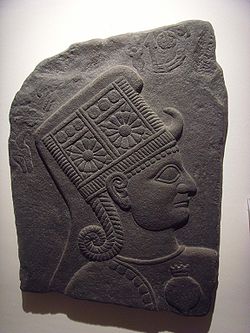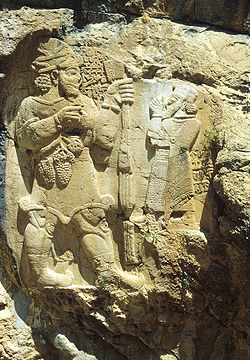Luwian religion
The Luwian religion describes the religious and mythological ideas of the Luwians , an Indo-European people in Asia Minor , which can be understood from the Bronze Age to the early Roman period . Throughout all periods it was exposed to strong external influences and a clear demarcation, especially from the Syrian and Hurrian religions , is not always possible. Obviously the Indo-European element was able to hold up better with the Luwians than with the related Hittites .
Periodization
In terms of religious history, the Luwian religion can be divided into two periods: the Bronze Age period and the Iron Age or late Luwian period. During the Bronze Age, the Luwians were under the rule of the Hittites . They spoke Luwian , a language close to Hittite . Although a hieroglyphic script was created in the Bronze Age, which was especially used to reproduce the Luwian, only a few religious writings of the Luwian from the Bronze Age are known.
After the collapse of the Hittite Empire, several late Luwian states were formed in northern Syria and south- eastern Anatolia , some of which came under Aramaic influence and were no later than the 8th century BC. Were subjugated by the Assyrians . Important Luwian centers at that time were Karkamis , Melid and Tabal .
The Luwian religion is still recognizable in southern Anatolia, especially in Cilicia , up until the early Roman times , especially in theophoric personal names.
According to scientific custom, Bronze Age names are transcribed with š and ḫ , but late Luwian names with s and h . y stands for “German” / j / The “nominative s” is omitted.
Bronze age
The oldest references to Luwians can be found in the archives of ancient Assyrian traders in the Karum Kaneš (around 1900 BC), where some personal names that can be clearly interpreted as Luwian occur, including theophore . Then u. a. Santa and Runtiya are worshiped as deities.
In Hittite texts, Luwian language pieces often appear in magical rituals for the purpose of purifying or healing people. The goddess Kamrušipa played an important role in this. Local cults are also attested, such as Ḫuwaššanna von Ḫubišna (today Ereğli ). The pantheon of the city of Ištanuwa , which is believed to be in the area of the Sakarya River , also belonged to the Luwian cult area.
Iron age
Luwian rulers and traders left behind from the 11th century BC. Several inscriptions giving ample evidence of the religious ideas of the Iron Age Luwians. There are also pictorial representations of deities, be it in the form of statues or bas-reliefs in the style of the Hittite rock art. A particularly large number of images of gods are known from Melid that were evidenced by a particularly pious king of the 10th century BC Were made. The reliefs show how the king libies before several deities . Below is a picture that obviously shows the myth of the snake fight of the weather god, which is reminiscent of the Hittite snake demon Illuyanka .
Ancient Anatolia
According to the evidence of theophoric personal names from ancient Anatolia, namely Cilicia and Lycaonia , the Luwian religion lived on until Roman times. The cult of Sandas in Tarsus , who was equated with Heracles , is known. In the Cappadocian Comana was Ma -Enyo worshiped, certainly an old cult that but can not be directly equated with a known Luwian or hethischen goddess. Similar traits, but also clear differences, can be found in the religion of the Lycians and Carians , who are considered close relatives of the Luwians.
Deities
The Luwian pantheon changed over time. Tarhunt, Tiwad, Arma, Runtiya and Santa can be seen as typical Luwian deities who were always worshiped, this is probably also true of the Syrian Kubaba. The Hurrian element - and through this also the Syrian and Babylonian - made itself felt later, with Iya, Hipatu, Saruma, Alanzu and Sauska. In contrast to the Hittite religion, the Hittite religion had little influence. In the Iron Age, Babylonian (e.g. Marutika = Marduk ) and Aramaic (Pahalat = Baʿalat / Baltis) influences were added, especially in the depiction of the deities.
Genuine Luwian deities
Tarḫunt / Tarhunt (nominative: Tarḫunz, Tarhunzas) was the weather and main god of the Luwians. In contrast to the Hittite Tarḫunna and Hurrian Teššup , his chariot was not pulled by bulls, but by horses. It is characteristic that the weather god took on clear traits of a vegetation god, as late Luwian portraits show, which depict Tarhunza with grapevines and ears of corn. One of his epithets piḫaššašši "of the lightning" was especiallyveneratedin Tarḫuntašša , the temporary capital of the Hittite Empire, and Tarḫunt piḫaššašši was also the personal god of King Muwatalli II. It is believed that the Greek wing horse Pegasus , which according to Herodus was the lightning wore, has Luwian origins.
According to late Luwian texts, Tarhunza gives royal power, strong courage and advances the army in the campaign. He confers victory and gives "areas to subjugate". In curse formulas, Tarhunz is supposed to "crush an opponent with his ax". He is often called "Heaven's Tarhunz". Its main cult city was Aleppo , a cult that dates back to the Bronze Age. The Hittite king Šuppiluliuma I installed his son Telipinu as priest and king in Aleppo.
As the "Tarhunza of the vineyard" ( Tarhunzas tuwarsas ) he was worshiped in Tabal . King Warpalawa of Tuwanuwa had the famous İvriz rock relief made, which depicts him with ears of corn and vines. A powerful spring rises from the rock relief, which underlines the fertility aspect of the weather god. Cattle and sheep were offered to him so that grain and wine might flourish.
In late Luwian reliefs Tarhunza is depicted as a bearded god with a short apron and helmet. In his right hand he is swinging an ax or a hammer, in his left he is holding a bundle of lightning . Sometimes he is shown standing on a bull, an adaptation to the weather god of Aleppo .
Late Luwian inscriptions from Arslantepe name other local weather gods, but little more than the name is known.
Tiwad (nom .: Tiwaz) was the sun god; a female sun goddess like the Hittites is not attested for the Luwians. One of his epithets was tati "father". The late Luwian king Aza-tiwada "Beloved by Tiwad" called him "Heaven's Tiwad".
Kamrušipa was the wife of Tiwad and through him mother of the protective deity Runtiya. It plays an important role in magical rituals. This goddess is not mentioned in late Luwian sources.
Arma was the moon god and appears to be a popular deity due to the large number of theophoric personal names that are formed with Arma (e.g. Armaziti "Man of Arma"). At the latest in the Iron Age the merger with the moon god of Harran took place , which is why late Luwian inscriptions often call him “Harranean Arma”. He is shown as a winged and bearded god with a crescent moon on his helmet. His name hieroglyph was a lunula, a moon-shaped pendant. In curse formulas he is asked to “grab the cursed by his horn”.
Runtiya was a protective deity. His animal was the deer and his name hieroglyph is a deer antler. In late Luwian texts he is mentioned in connection with game and may therefore also have been the god of hunting. He is depicted as a god armed with a bow and arrow and standing on a stag. His companion is the goddess Ala , whomerged with Kupapain Kummuh .
Santa / Santa was a deadly deity along with the dark Marwainzi is called. Also Nikarawa may collectively called in spätluwischen texts with the Marwainzi. This otherwise unknown deity was asked that she or her dogs should eat an adversary. Santa wasequatedwith the Babylonian Marduk in the Bronze Age. His cult lived on in the Cilician Tarsus until ancient times, where he wasequatedwith Heracles .
The goddess of fate Kwanza and the plague god Iyarri are only indirectly mentioned in late Luwian names . During the Bronze Age, the former was known as Gulza.
Originally Huritto-Syrian deities
Kupapa was one of the most important deities of the late Luwian pantheon. Her attributes include a mirror and the pomegranate . Her companion was Karhuha . Originally the city goddess of Karkamis , her cult spread throughout Anatolia during the Iron Age and she was known as the Kufaws / Kubaba of the Lydians . Whether the Phrygian goddess Cybele originated from Kubaba remains controversial. The late Luwian kings of Karkamis venerated her as "Kupapa, Great Queen of Karkamis". In curse formulas, Kupapa is asked to attack the opponent from behind or that Kupapas hasami dog pursue and eat him.
Hipatu or Hiputa was the late Luwian name of the Hurrito-Syrian goddess Ḫebat . She is depicted as an enthroned goddess together with Saruma (hurr. Šarruma ), who is her son according to Hittite evidence , standing on a mountain . The latter is often mentioned together with Alanzu , who according to Hittite texts was his sister. Together with Tarhunz he advances the army and "steals the enemy the victory". His epithet is "Mountain King".
Sauska isdepictedon a late Luwian relief from Melid as a winged goddess with an ax standing on two birds.
Kumarma was the grain goddess who was invoked along with Matili and the wine god Tipariya. The deity is derived from the Hurrian god Kumarbi .
Individual evidence
- ↑ Manfred Hutter: Aspects in Luwian Religion ; P. 215
- ↑ Manfred Hutter: Aspects in Luwian Religion ; P. 223
literature
- H. Craig Melchert (Ed.): The Luwians ; BTE, Vol. 68, Boston 2003. ISBN 90-04-13009-8
- Maciej Popko : Religions of Asia Minor ; Warsaw 1995. ISBN 83-86483-18-0 .
- Piotr Taracha : Religions of second millenium Anatolia . ISBN 978-3-447-05885-8 .
- Manfred Hutter : Aspects in Luwian Religion. In: H. Craig Melchert (Ed.): The Luwians (= Handbuch der Orientalistik. Volume 1.68). Brill, Leiden 2003, ISBN 90-04-13009-8 , pp. 211-280.


